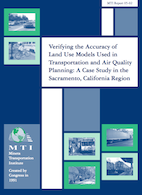- 408-924-7560
- mineta-institute@sjsu.edu
- Donate
Verifying the Accuracy of Land Use Models Used in Transportation and Air Quality Planning: A Case Study in the Sacramento, CA Region
Governmental bodies in the United States are implementing more advanced land use and travel demand models to meet air quality conformity and environmental impact statement requirements. To help guide model applications in policy studies, this report describes an evaluation of model accuracy and induced demand representation over a 10-year period in an integrated land use and transportation model, the 2000 Sacramento MEPLAN model. The accuracy evaluation shows relatively high error levels for zonal land use forecasts. More zones have lower percentage errors for employment and nonresidential land forecasts (56 and 34 percent, respectively, within +50 percentage points) relative to household and residential land forecasts (14 and 18 percent, respectively, within +50 percentage points). There are smaller errors in established central urban areas and larger errors in the outer ring. The model underestimates average vehicle travel speeds by 4 percent and vehicle miles traveled by 3 percent.
Induced demand analysis shows that new transportation capacity produced absolute percent changes in the zero to 25 percent range for 75 and 85 percent of zones for households and residential land, respectively, and in the 26 to 50 percent range for 30 and 35 percent of zones for employment and nonresidential land, respectively. Relative to estimated actual induced travel, the model overestimated the number of zones with smaller changes and underestimated the number of zones with larger changes (1 to 19 percent). Total estimated actual induced change by zone showed losses in older employment and suburban regional centers and gains in the outer ring. The share of significant model-induced employment and nonresidential land (greater than zonal absolute model error) relative to the regional total was 14 and 21 percent, respectively; 3 percent for households; and 1 percent for residential land. Roadway expansion increased vehicle miles traveled 5 percent and average travel speed 16 percent with 0.28 elasticity. Using the model for conformity analysis, the regional transportation plan emissions analysis should fall outside model error to demonstrate conformity. In environmental impact analyses of new roadway projects, model errors tended to underestimate no-build travel and project need. The magnitude of change from the no-build alternative to the highway alternative should be greater than the absolute value of model error to be a significant improvement. For both conformity and environmental impact analyses, this study indicates that land use changes from a new project may be significant and should be included in valid evaluations as required by current regulations.
CAROLINE RODIER, PhD
Caroline Rodier has a PhD in Ecology from the University of California, Davis with emphasis in environmental policy analysis and transportation planning. She has more than 10 years experience applying land use, travel, and emissions models to evaluating the effects of a wide range of transportation and land use policies. Her most recent research in this area addresses key issues of modeling uncertainty in the context of environmental impact and air quality conformity processes. Dr. Rodier is currently a post-doctoral researcher at Partners for Advanced Transit and Highways at the University of California, Berkeley. In this position, she is conducting evaluation research of field operational tests that involve the application of advanced technologies to enhance access to transit, for example, smart parking and shared-use low-speed modes connected to Bay Area transit stations. She has authored more than 15 journal articles and more than 30 reports and proceedings articles.
-
Contact Us
San José State University One Washington Square, San Jose, CA 95192 Phone: 408-924-7560 Email: mineta-institute@sjsu.edu






